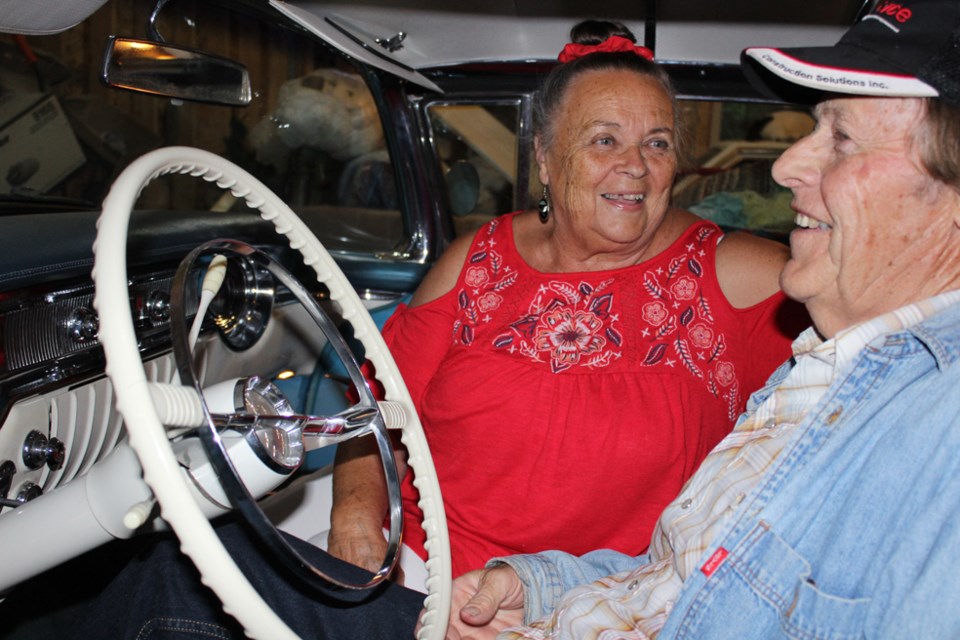Located within the Kenton community, organic farmers Harvey and Bonnie Sangster are ‘keepers of the key’ to aspects of culture and customs upon which much of the area has been built.
They value their virgin prairie bordering a ravine and the section farm, Frosty Brae, is under a conservation agreement.
A stop to see the shiny vintage ‘56 hardtop Oldsmobile and the small garden plough and other early 20th century centerpieces in the front yard prepares visitors for the Sangster’s enjoyment of heritage.
Stepping into the kitchen, lacy valence above the sink window sets off a unique bird feeder just feet outside the window, with an assortment of small birds picnicking. “You know who made that, was Mr. Harry Kilford.” Bonnie Sangster tells.
The feeder has had a famous visitor as well, “A gray-crowned rosy finch, and it was so rare, people were coming for miles to take pictures of the bird,” says Harvey.
“They came out from Winnipeg to take pictures of the bird,” Bonnie chimed in.
This finch is native to western Canada, and the north-western USA. Due to its remote alpine habitat it is rarely seen, (until some of those finches visited Frosty Brae).
Young woodpeckers have been frequenting the feeder and, “we have baby sparrows. The mother is teaching them to eat for themselves,” Harvey commented on the current diners.
On more than one occasion Harvey has moved nests out of the way of farming.He tells of a killdeer that fussed in front of his tractor, her nest in the path of cultivating, seeding and harrowing operations. He moved the nest with eggs three times and the mother returned to the nest each time.
“It was kind of rewarding to know that little bird was brave enough to defend her nest and I saved the nest.”
Harvey’s father and mother passed down a love for animal life. “My dad was an excellent horseman and taught us how to look after animals, properly. Fed them properly and on time. You took care of your animals.”
The Sangster home hosts memorabilia of the Royal Family in what was Bonnie’s English-style tea room a few years ago. Served on bone China, tea was held in the dining room of what was once Mabel Brandon’s home.
After the renowned Kenton music teacher passed away Sangsters didn’t want to see her home neglected or demolished. They purchased the two-story house and moved it to add on to their farmhouse. “When I was six years old, I took piano lessons in this house, when it was in Kenton,” said Harvey.
Another treasure is an Eaton’s catalogue, nearly a century old. “This is of interest to me,” said Bonnie, reading from a page: “Extra good value is offered in this high-grade diamond ring… ½ karat, set in a beautiful 18 karat yellow gold engraved setting with platinum cup. A sterling silver box is supplied with this ring…The price delivered is $150.”
A bargain? But, never mind, an entire hardwood dining room suite was listed: “Moderately priced, new design, solid oak suite … a hundred bucks!”
Attached to that catalogue is the story of a young lad of German extraction, taught by Sangster’s mother, teacher Miss Edna Robinson.
One day Miss Robinson heard a knock on the door and there was a man standing with his school-aged son, whom he turned over to her, asking her to teach the boy.
She soon realized the boy did not know a word of English and she didn’t know German, but she made the young student feel comfortable in her multi-grade classroom. Miss Robinson devised a way to use the Eaton’s catalogue as her reference book, complete with words and pictures, to make the English language understood. The boy grew to be a successful man of the Virden area, says Sangster.
Harvey’s father came over from Scotland in 1920 after serving in the British army in the First World War. “It has been 100 years in March that my dad actually landed on this farm.”
Rural life for Harvey, near Lenore and Kenton, meant everyone knew everyone else, but Bonnie’s early childhood had real similarities although she grew up in Winnipeg.
She is a story teller with a photographic memory. One of Bonnies first vignettes to be published in The Senior Paper (Regina publication) was of her life revolving around that St. Vital street.
“There was 36 of us kids, all different nationalities. It was like a little village. The women didn’t work. And if your ‘little Johnny’ did something wrong, a mother would smack his bum and when he got home, his own mother smacked his bum. That’s the way those kids were all raised.”
Harvey tells how helpful the telephone switchboard operators were to rural life. Occasionally, if someone needed a ride to Brandon, the local switchboard operator would be consulted to see who might be going to town that day.
Or if a call was being placed to a friend and the ‘line was busy’, the operator might know if the friend was about to end that conversation.
Harvey said, “People didn’t mind because nobody had anything to hide. You were glad to share what you were doing with other people. It was really unique.”




